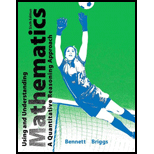
Type of Study. Determine whether the following studies are observational studies or experiments. If the study is an experiment, identify the control and treatment groups, and discuss whether single-or double-blinding is necessary. If the study is observational, state whether it is a case-control study, and if so, identify the cases and controls.
36. A National Cancer Institute study of 716 melanoma patients and 1014 cancer-free patients matched by age, sex, and race found that those having a single large mole had twice the risk of melanoma. Having 10 or more moles was associated with a 12 times greater risk of melanoma (Journal of the American Medical Association).
Want to see the full answer?
Check out a sample textbook solution
Chapter 5 Solutions
Using and Understanding Mathematics: A Quantitative Reasoning Approach plus NEW MyMathLab with Pearson eText -- Access Card Package (6th Edition) (Bennett Science & Math Titles)
- 3. For each statement below, write an equivalent statement using the justification given. = y Є A or yЄ B by the definition of union = y Є A or y Є B by the definition of set complement = x = C and x & D by DeMorgan's Law =Vx (x EnFxЄEUF) by definition of subset. = (X CYUZ)A (YUZ CX) by definition of set equalityarrow_forward6. Let A, B, and C be arbitrary sets. Prove that A - (BNC) = (A - B) U (A – C)arrow_forward2. Find the cardinality of each set. {x = Z: |x| ≤ 5} {-2, 1, 4, 7, 10,..., 52} {{7,9}, 2, {1, 2, 3, 4, 7}, {9}, {0}}arrow_forward
- A system of inequalities is shown. y 5 3 2 1 X -5 -4 -3 -2 -1 0 1 2 3 4 5 -1- Which system is represented in the graph? Oy>-x²-x+1 y 2x²+3 -2 -3 тarrow_forwardWhich set of systems of equations represents the solution to the graph? -5 -4 -3 -2 Of(x) = x² + 2x + 1 g(x) = x²+1 f(x) = x²+2x+1 g(x) = x²-1 f(x) = −x² + 2x + 1 g(x) = x²+1 f(x) = x² + 2x + 1 g(x) = x²-1 -1 5 y 4 3 2 1 0 -1- -2 -3- -4. -5 1 2 3 4 5arrow_forwardWhich of the graphs below correctly solves for x in the equation -x² - 3x-1=-x-4? о 10 8 (0,2) -10 -8 -6 -2 2 4 6 8 10 (-4,-2) -2 + (0,2) (4,6) -10-8-6-4-2 -2 2 4 6 8 10 (-3, -1) -2 2 (1-5) -6 -8 -10 10 -10-8-6-4-2 2 6 8 10 (2,0)arrow_forward
- Unit 1: Logic 1. Let P be the statement "x > 5” and let Q be the statement “y +3≤ x," and let R be the statement “y Є Z.” (a) Translate the following statements to English. (b) Negate the statements symbolically (c) Write the negated statements in English. The negations should not include any implications. • (QV¬R) AP • (P⇒¬Q) VR • (PVQ)¬R 2. Let R, S, and T be arbitrary statements. Write out truth tables for the following statements. Determine whether they are a tautology or a contradiction or neither, with justification. ⚫ (RAS) V (¬R ⇒ S) (R¬S) V (RAS) • (TA (SV¬R)) ^ [T⇒ (R^¬S)]arrow_forward10. Suppose the statement -R (SV-T) is false, and that S is true. What are the truth values of R and T? Justify your answer.arrow_forward5. Rewrite the statements below as an implication (that is, in "if... then..." structure). n is an even integer, or n = 2k - 1 for some k Є Z. x²> 0 or x = 0. 6. Rewrite each statement below as a disjunction (an or statement). If I work in the summer, then I can take a vacation. • If x2 y.arrow_forward
- 4. Negate the following sentences. Then (where appropriate) indicate whether the orig- inal statement is true, or the negation is true. ⚫ If I take linear algebra, then I will do my homework or go to class. • (x > 2 or x < −2) ⇒ |x| ≥ 2 • P⇒ (QVR) ⇒(¬PV QV R) Vn EN Em E Q (nm = 1) • Ex E N Vy & Z (x. y = 1)arrow_forward8. Give three statements that are logically equivalent to x ≥ 0⇒ (x² = 0V −x < 0). You may use any equivalences that you like.arrow_forward3. Let P, Q, and R be arbitrary statements, and let x E R. Determine whether the statements below are equivalent using whatever method you like. • • -[-P → (QVR)] and ¬(¬P V Q) A¬R (PA¬Q) ⇒(¬PVS) and (SVP) VQ • x = 4 and √√√x=2 x = 4 and x2. = 16arrow_forward
 Glencoe Algebra 1, Student Edition, 9780079039897...AlgebraISBN:9780079039897Author:CarterPublisher:McGraw Hill
Glencoe Algebra 1, Student Edition, 9780079039897...AlgebraISBN:9780079039897Author:CarterPublisher:McGraw Hill Big Ideas Math A Bridge To Success Algebra 1: Stu...AlgebraISBN:9781680331141Author:HOUGHTON MIFFLIN HARCOURTPublisher:Houghton Mifflin Harcourt
Big Ideas Math A Bridge To Success Algebra 1: Stu...AlgebraISBN:9781680331141Author:HOUGHTON MIFFLIN HARCOURTPublisher:Houghton Mifflin Harcourt College Algebra (MindTap Course List)AlgebraISBN:9781305652231Author:R. David Gustafson, Jeff HughesPublisher:Cengage Learning
College Algebra (MindTap Course List)AlgebraISBN:9781305652231Author:R. David Gustafson, Jeff HughesPublisher:Cengage Learning
 Holt Mcdougal Larson Pre-algebra: Student Edition...AlgebraISBN:9780547587776Author:HOLT MCDOUGALPublisher:HOLT MCDOUGAL
Holt Mcdougal Larson Pre-algebra: Student Edition...AlgebraISBN:9780547587776Author:HOLT MCDOUGALPublisher:HOLT MCDOUGAL




